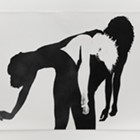
Finally, it’s time.
He sits in one place, but he isn’t still. He shivers with excitement before his tiny frame cannons over a plastic jump, then another, then two more.
Three and a half years ago, Jack Cotter, 65, couldn’t walk from one jump to another, he says. But tonight, inside a covered barn near the state line, he’s running alongside, even slightly ahead of his fuzzy, wirehaired fox terrier, Tucker.
Cotter had both hips and one knee replaced. He broke parts of his back twice while serving in the Navy from 1965-70, and doctors told him he’d probably be in a wheelchair by now, he says. But these days he’s running with Tucker in agility classes twice a week and regularly competing.
“If I could do five nights a week, I would,” he says.
The Association for Pet Obesity Prevention, founded by a veterinarian and Ironman triathlete, estimates that 54 percent of American pets are overweight. (Meanwhile, 35.7 percent of U.S. adults are obese, according to the CDC.) Obesity in pets, like humans, can lead to plenty of other health problems, including high blood pressure, breathing problems, kidney disease and shortened life expectancy. Along with food choices, exercise is a huge factor in how humans affect their pets’ health.
Agility classes can help owners as much as they help pets, whether for weight management or mobility.
Barb Davis, who teaches classes at Stride Ahead Agility and has competed in agility competitions all over the world, says many of her students wouldn’t be exercising if they weren’t doing this activity with their dog.
“It’s an interesting little bond you have leading your dog around like this,” she says. “People enjoy the physical and the mental part of it. It’s a friend of theirs, and they pull it off together.”
Before each class, Davis walks through the course with her students.
“It really helps if you can get your butt up here ahead of your dog,” she tells Cotter’s class. They all nod.
But there’s more to these evenings in the barn than just running around with your dog.
“It’s a very mentally challenging sport as well,” she says. “That’s what drew me to it. I really enjoy the puzzle of figuring out how to send your dog where you want them to go.”
As the students wait for class on this Tuesday night, the covered indoor arena smells like meaty dog treats and sawdust. Cotter fills his pocket with treats he made at home from beans, yams and pumpkin, and leads Tucker inside, where seven other owners and a few of their dogs wait patiently. (Most of the dogs, like Tucker, get so excited they have to be kept in the car until it’s their turn to run the course.)
Cotter’s excited, too. He taps his index and middle fingers against his thumb as he walks the course and works through it in his mind. Participants don’t know what the order of the obstacles will be until they show up for a class or competition.
Cotter started the classes on a whim, but now says he’s addicted. He says they’ve been a way to strengthen his health physically and mentally, even improving his memory. He tells the story of forgetting his son’s order every time the pair goes out for coffee. On their most recent outing, he didn’t forget.
“Then I just said it: ‘And a white coffee and peppermint mocha with nonfat milk,’” Cotter says. “Things like that, day to day, you notice it.”
On the course, his gait is a little wobbly, but he keeps up and his concentration is sharp as he flicks his wrists from the hand signal for “jump” to the one for “tunnel.”
Tucker understands. His furry, tan body flashes into a tarp-like vinyl tunnel before a few more jumps, a teeter-totter and a bridge. The pair finishes the course. They both look excited — and out of breath.
“My doctor told me about three weeks ago that I’m in better physical shape than I was 20 years ago,” Cotter says.
He looks down at Tucker, who’s sniffing the ground near his shoe and whipping his nub of a tail back and forth.
“I thank him every day.”
Read more about pets and your health in the current issue of InHealthNW, where this article first appeared.


















